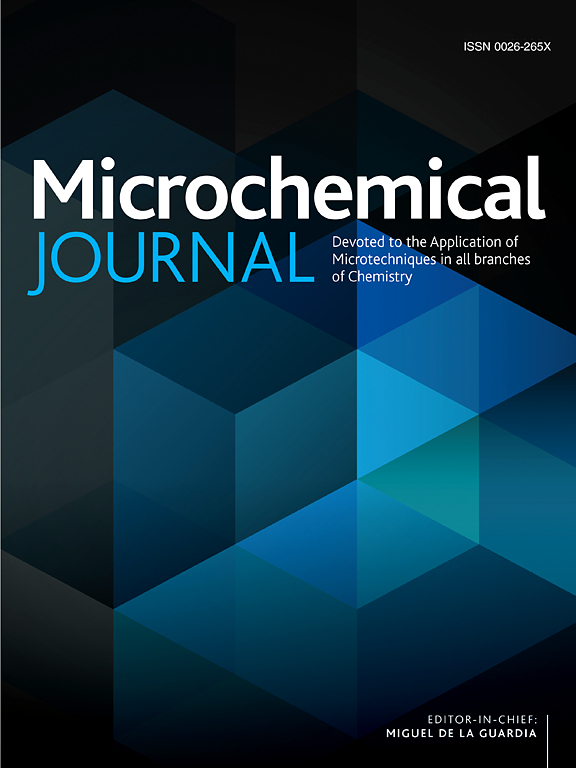基于Fe3O4/CDs@MIPs的分子印迹荧光传感器检测胃癌标志物对羟基苯甲酸
IF 4.9
2区 化学
Q1 CHEMISTRY, ANALYTICAL
引用次数: 0
摘要
随着代谢组学的快速发展,尿液中对羟基苯甲酸已被确定为胃癌早期检测和筛查的重要生物标志物。在本研究中,我们设计并合成了一种新型的磁性空心碳点分子印迹荧光传感器(Fe3O4/CDs@MIPs),以实现对该生物标志物的高灵敏度和选择性检测。将Fe3O4纳米颗粒掺入传感器中,显著提高了传感器的识别能力和分析性能。该荧光传感器在0 ~ 100 μmol/L浓度范围内具有较强的线性响应,检测限为0.37 μmol/L。该传感器表现出优异的特异性,显示出来自普通阳离子、阴离子、氨基酸和结构类似物的最小干扰,强调其对羟基苯甲酸的高选择性。在实际应用中,对胃癌患者和健康人的尿液样本进行了尖峰恢复实验,其回收率为95.00% ~ 106.67%,相对标准偏差为0.76% ~ 2.80%。这些结果证实了传感器出色的准确性,重复性和稳定性。总体而言,Fe3O4/CDs@MIPs传感器为检测尿液中的胃癌生物标志物提供了一种强大的非侵入性仪器,为胃癌的早期诊断和监测提供了巨大的潜力。本文章由计算机程序翻译,如有差异,请以英文原文为准。
Molecularly imprinted fluorescence sensor based on Fe3O4/CDs@MIPs for detecting the gastric cancer marker p-Hydroxybenzoic acid
With the rapid development of metabolomics, p-Hydroxybenzoic acid in urine has been identified as a crucial biomarker for the early detection and screening of gastric cancer. In this study, we designed and synthesized a novel magnetic hollow carbon dot molecularly imprinted fluorescence sensor (Fe3O4/CDs@MIPs) to achieve high sensitivity and selectivity detection of this biomarker. The incorporation of Fe3O4 nanoparticles into the sensor significantly improved its recognition capability and analytical performance. The fluorescence sensor exhibited a strong linear response within the concentration range of 0–100 μmol/L, with an impressive detection limit of 0.37 μmol/L. The sensor demonstrated excellent specificity, showing minimal interference from common cations, anions, amino acids, and structural analogs, underscoring its high selectivity for p-Hydroxybenzoic acid. In practical applications, spike recovery experiments conducted on urine samples from both gastric cancer patients and healthy individuals revealed recovery rates ranging from 95.00 % to 106.67 % and relative standard deviations between 0.76 % and 2.80 %. These results confirmed the sensor’s outstanding accuracy, reproducibility, and stability. Overall, the Fe3O4/CDs@MIPs sensor provides a robust, non-invasive instrument for detecting gastric cancer biomarkers in urine, offering significant potential for early diagnosis and monitoring of gastric cancer.
求助全文
通过发布文献求助,成功后即可免费获取论文全文。
去求助
来源期刊

Microchemical Journal
化学-分析化学
CiteScore
8.70
自引率
8.30%
发文量
1131
审稿时长
1.9 months
期刊介绍:
The Microchemical Journal is a peer reviewed journal devoted to all aspects and phases of analytical chemistry and chemical analysis. The Microchemical Journal publishes articles which are at the forefront of modern analytical chemistry and cover innovations in the techniques to the finest possible limits. This includes fundamental aspects, instrumentation, new developments, innovative and novel methods and applications including environmental and clinical field.
Traditional classical analytical methods such as spectrophotometry and titrimetry as well as established instrumentation methods such as flame and graphite furnace atomic absorption spectrometry, gas chromatography, and modified glassy or carbon electrode electrochemical methods will be considered, provided they show significant improvements and novelty compared to the established methods.
 求助内容:
求助内容: 应助结果提醒方式:
应助结果提醒方式:


